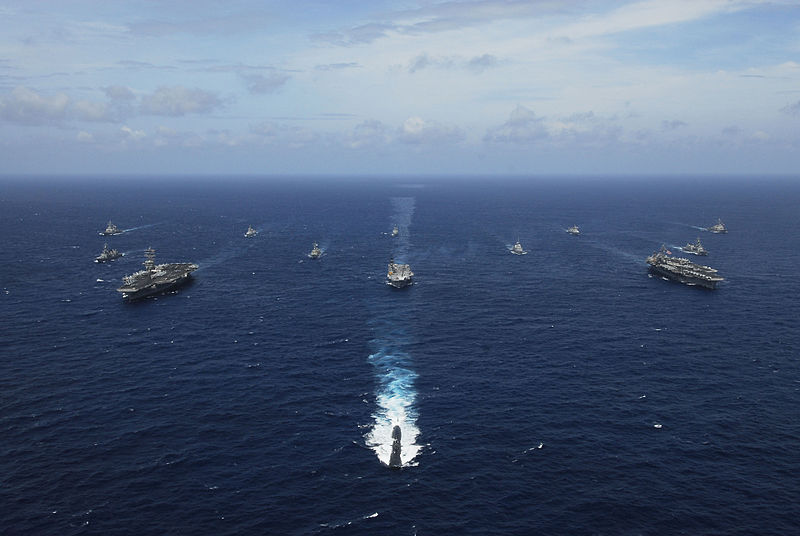Over the past couple of days, I joined a couple of my ASPI colleagues at a second track ‘Quad plus’ dialogue convened in Canberra by the Washington-based Heritage Foundation. (A second track dialogue involves academics but no officials). The meeting brought together academics and think tank researchers from the four Quadrilateral Security Dialogue partners from 2007 (Australia, India, Japan and the United States), with the ‘plus’ part being scholars from The Philippines and Indonesia. India and Japan were represented by the Vivekananda International Foundation and the Tokyo Foundation respectively.
The aim of the dialogue—the first of its kind—was to explore the benefits of reinvigorating the Quad security arrangement as a collective security mechanism. I say ‘reinvigorate’ because impetus behind the Quad really reached its peak back in 2007, when the first (and so far only) official meeting took place, including Australian PM John Howard. Australia withdrew after the election of the Rudd Government and the idea fell away markedly after that, although it’s questionable how much vigour there was in the first place. In 2008, Lowy’s Rory Metcalf observed that it was never as substantial a body as its supporters and detractors claimed, though he added that the idea mightn’t be quite as dead as it seemed at the time.
That was a prescient observation, and there’s some momentum today for having another look at the concept. Japan’s Prime Minister Abe has spoken of a ‘security diamond‘ of the four countries, along with an intention of pursuing a diplomatic strategy based on a promotion of liberal democratic ideals. Abe was also a vigorous backer of the Quad concept in his previous stint as PM. There might also be support here in Australia; back in 2010, then Opposition leader Tony Abbott was critical of Australia unilaterally pulling out of the Quad—perhaps not surprisingly, given the enthusiasm of former PM Howard.
The Quad is in many ways a values-based concept, organised around shared liberal democratic principles. Values are strong things, and there’s a lot to be said for like-minded countries getting together to caucus on things they deem to be important. But there’ll be some practical difficulties too. Working against the idea are three factors.
The first is that any grouping based on membership requirements that not every country can meet (in this case a democratic political system) necessarily has exclusions. In his case the obvious exclusion is China, and it would be difficult to reinvigorate the Quad in any meaningful way without sending an implicit message to Beijing that it’s a hedging mechanism against Chinese power. That said, there’s much to be said for strength in numbers, and the collective ability of the Quad to shape the regional environment and create public goods if it puts its shoulders to the wheel shouldn’t be underestimated. And the fact that a meeting of democracies is likely to be seen as threatening by authoritarian China shouldn’t necessarily be a show stopper—the many shouldn’t be dictated to by the few. But putting China offside isn’t cost free and is likely to produce its own set of difficulties and the question is whether those difficulties would outweigh the benefits.
The second potential downside is the converse of the first. There’ll be some countries that tick the boxes for membership but are relegated to a ‘plus’ status—or may opt to sit out altogether. What, for example, is the role of other American allies that are also democracies, such as South Korea? New Zealand is a robust democracy and shares the liberal democratic values of the Quad partners, but also has an independent view of security matters which we’ve seen play out as recently as last week, when NZ saw no need to follow the lead of Australia, Japan and the United States in criticising China’s ADIZ declaration.
The final impediment to deeper Quad security arrangements is that the Quad countries all have their own narrow interests in addition to an overarching interest in supporting a world order based on the rule of law, human rights and democracy. This was one of the reasons for Australia cooling on the idea in the second half of 2007. Prior to being elected PM, Rudd explained his reservations about hitching Australia’s wagon to other country’s security in the context of the then recent Japan-Australia security cooperation declaration. Rudd was broadly supportive, but cautioned against a mutual security pact, saying that ‘to do so at this stage may unnecessarily tie our security interests to vicissitudes of an unknown security policy future in northeast Asia’.
But that’s the thing about security relationships. To get the benefits—in this case the support on security matters from countries with shared values and largely interoperable militaries—you also have to accept the costs. In the case of the Quad, Australia would also be buying into vicissitudes beyond northeast Asia, such as security tensions on the India-China border. Adding one or more ‘plus’ members would add the security interests of yet more countries to the list—and there are plenty of vicissitudes to go around.
Values have a place in formulating foreign policy and security strategy. If nothing else, it’s easier to work with countries with shared values because communication is easier and the calculus of self-interest tends to be similar. The Quad are natural partners in many ways, though it remains to be seen whether a values-based grouping can be constructive within the broader Indian-Pacific security architecture. There are costs as well as benefits, and any Australian engagement with the Quad (plus) concept will have to balance those.
Andrew Davies is senior analyst for defence capability at ASPI and executive editor of The Strategist. Image courtesy US Navy via Wikimedia.


